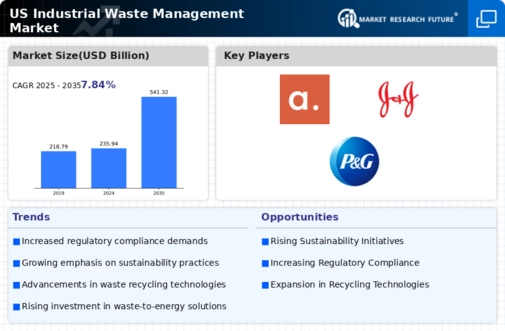Increasing Regulatory Scrutiny
The industrial waste-management market is experiencing heightened regulatory scrutiny as federal and state agencies enforce stricter environmental regulations. This trend compels industries to adopt more sustainable waste management practices. For instance, the Environmental Protection Agency (EPA) has implemented regulations that require companies to minimize waste generation and enhance recycling efforts. As a result, businesses are investing in advanced waste management technologies to comply with these regulations, which is likely to drive market growth. The market is projected to reach approximately $20 billion by 2026, reflecting a compound annual growth rate (CAGR) of around 5%. This increasing regulatory environment is a key driver for the industrial waste-management market, pushing companies to innovate and improve their waste handling processes.
Rising Environmental Awareness
Growing environmental awareness among consumers and businesses is significantly influencing the industrial waste-management market. As stakeholders become more conscious of their ecological footprint, there is a rising demand for effective waste management solutions. Companies are increasingly adopting practices that align with sustainability goals, which often include reducing waste generation and enhancing recycling initiatives. This shift is evident in various sectors, including manufacturing and construction, where firms are investing in waste reduction technologies. The market is expected to grow as organizations seek to improve their environmental performance, with estimates suggesting a potential increase in market size to $25 billion by 2027. This heightened awareness is a crucial driver for the industrial waste-management market, as it encourages the adoption of innovative waste management strategies.
Investment in Sustainable Practices
Investment in sustainable practices is becoming a focal point for many industries, significantly impacting the industrial waste-management market. Companies are increasingly recognizing the long-term benefits of sustainable waste management, which not only helps in compliance with regulations but also enhances their brand reputation. This trend is leading to increased funding for waste reduction initiatives and recycling programs. According to recent estimates, investments in sustainable waste management practices could reach $15 billion by 2025. This growing commitment to sustainability is a vital driver for the industrial waste-management market, as it encourages businesses to adopt innovative solutions that minimize waste and promote environmental stewardship.
Economic Growth and Industrial Expansion
The industrial waste-management market is closely linked to economic growth and industrial expansion in the United States. As industries expand, the volume of waste generated increases, necessitating more robust waste management solutions. The manufacturing sector, in particular, is a major contributor to waste generation, and its growth is expected to drive demand for waste management services. Recent data indicates that the manufacturing sector has seen a growth rate of approximately 4% annually, which correlates with an increase in waste production. This economic expansion is likely to propel the industrial waste-management market, as companies seek efficient ways to handle their waste streams while adhering to regulatory requirements.
Technological Innovations in Waste Treatment
Technological innovations are transforming the industrial waste-management market, enabling more efficient waste treatment and disposal methods. Advanced technologies such as artificial intelligence, machine learning, and automation are being integrated into waste management processes, enhancing operational efficiency and reducing costs. For example, smart waste management systems can optimize collection routes and improve sorting processes, leading to higher recycling rates. The market is witnessing a surge in investments in these technologies, with projections indicating a growth rate of 6% annually over the next five years. This technological evolution is a significant driver for the industrial waste-management market, as it allows companies to manage waste more effectively while minimizing environmental impact.














Leave a Comment